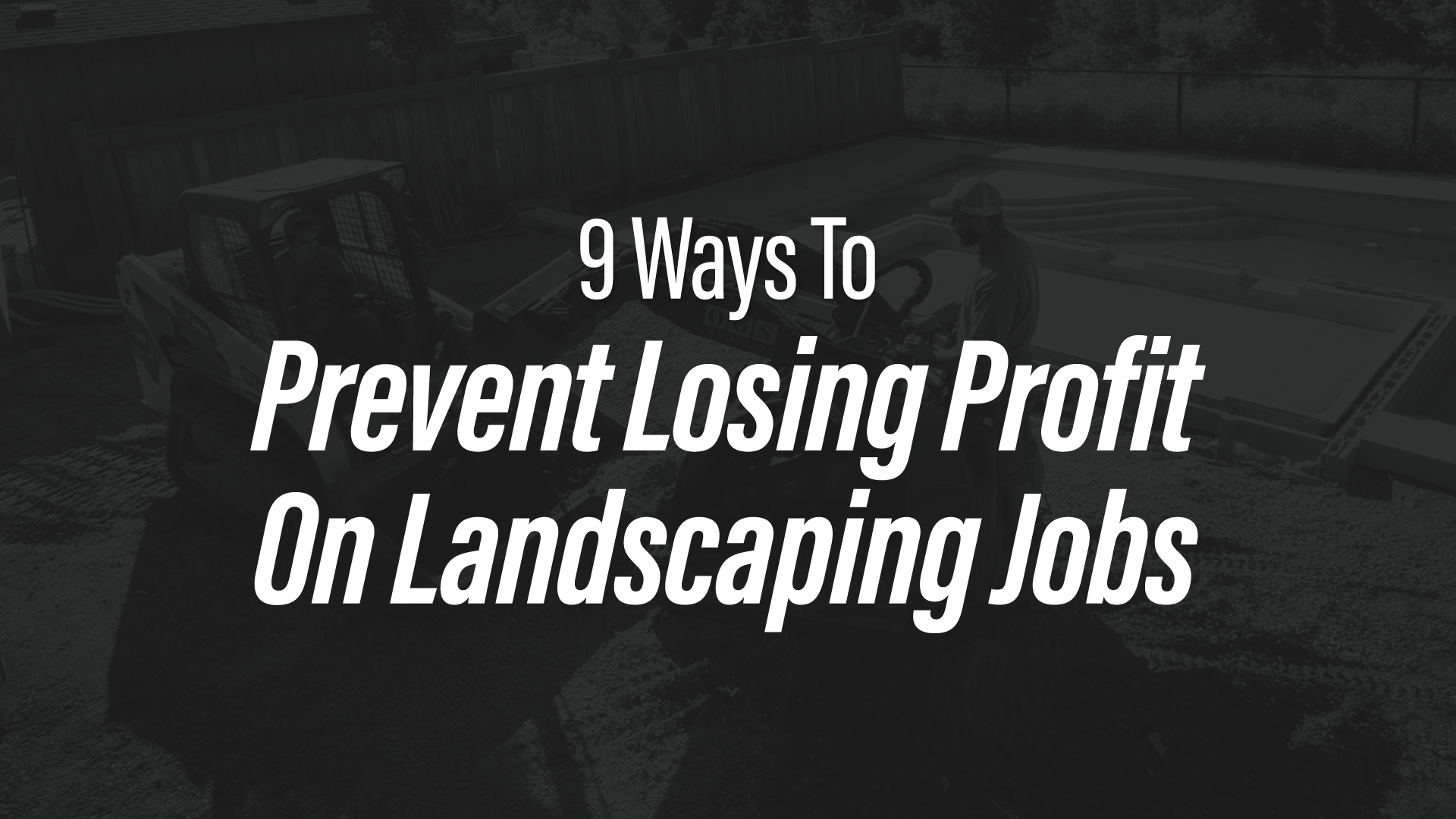Many landscape businesses are burning through cash quicker than they realize. Lean is a concept that originated in the manufacturing industry to help keep businesses profitable. Incorporating Lean thinking is used to identify and minimize wasteful processes that reduce efficiency within a business. The landscaping industry can easily adopt Lean to identify where certain operations can become more efficient. It all starts with eliminating wasteful functions that eat into potential profits on future and current landscaping jobs. We’ll show you the different ways through Lean thinking on how your landscape business is burning profits through wasteful processes and systems, and what you can do to minimize the damage.
In this landscaping article, we’ll cover:
- Waste #1: Overproduction
- Waste # 2: Waiting
- Waste #3: Transportation
- Waste #4: Overprocessing / Too Many Steps
- Waste #5: Unnecessary Inventory
- Waste #6: Job Defects and Reworks
- Waste #7: Unnecessary Motion
- Waste #8: Human Talent or Potential
- Waste #9: Resistance to Change
- Save Your Landscape Business Time and Money With Software
Waste #1: Overproduction
If your landscape business needs to excavate 12 feet for a pool installation job, you should not be over-excavating a few feet past what it needs to be. It’s a waste of time, effort, and you’re not getting paid any extra for something you weren’t asked to do. Overproduction like this is a major culprit of common financial waste in landscaping businesses, and can take chunks out of your budget in any given landscaping, design/build, or even lawn care jobs. Being over-prepared and overproducing will not be rewarded no matter how well your intentions are. Make sure your landscaping crews have what they need and when they need it through a combination of proper training and effective design.
Waste # 2: Waiting
The easiest way to lose profit on a landscaping job is to just stand around and wait. It’s obvious that waiting is a complete waste of time, but have you considered how much money is being burned after you add the value of every minute across a crew? A slight hiccup in operations can eat hundreds of dollars a minute depending on the size of the job, and because time is money, profits decrease by the minute when labor or resources are waiting for the next step to begin. It’s jaw dropping to see the wasteful effects of waiting when you check out what landscaping costs per hour in labor alone.
We see examples of crews ‘on stand by’ all the time. From waiting for the operation manager’s instructions and equipment arrivals to waiting in line for fuel or for supply deliveries, when it comes to your bottom line it doesn’t pay to play the waiting game.
Waste #3: Transportation
Transportation is a necessary cost for landscaping businesses. On one hand, it’s the cost of business to get from yard to site; on the other hand, it’s easy to waste money on transportation costs. There are times when it’s excessively wasteful, like when it’s related to transporting equipment that’s shared, old or poorly maintained. Sharing equipment between crews may seem like a way to save money but the time lost transporting equipment between sites translates to lost revenue.
When old equipment breaks down, it needs to be transported to a repair facility, a replacement needs to be transported to the job site and then both must eventually be transported back to their proper locations. Bringing it back to waiting as a colossal waste of money, consider that while the equipment is being transported, landscaping crews are less productive, labor costs are rising, and job schedules are extending. The financial waste feeds off of each other compounding into a giant money pit for your landscaping business.
Poor estimates and poor planning can ramp up to unnecessary travel as well. The constant back and forth from site to hardware store because you forgot twine, a particularly sized screw bit head, or something painfully small can add up to wasting time with waiting, travel, and adding unnecessary inventory to your business. This can be avoided through proper job planning, thorough estimates, and an organizational structure that’s standardized from the top down in your landscape business.
Transportation costs are tough to fix, but there are steps to take to minimize costs. Firstly, make sure you’re taking the most efficient route from site to site or yard to job. Naturally some routes are faster than others, others are less start and stop that eat into your gas, or planning your routes properly for the day from site to site can save both gas and time. LMN’s Routing tool makes sure you’re getting where you need to go as quickly as possible and in the right order to help you save on time and gas. Secondly, make sure you’re making the proper equipment purchases and providing proper maintenance so that you’re not stuck with defective equipment that will put a whole job on hold, or waiting on a hardware store trip to pick up equipment you should have on site.
Waste #4: Overprocessing / Too Many Steps
Every business needs quality control steps to make sure that careless mistakes aren’t made at the end of a job. While quality control is essential, there are such things as too many inspections or sign-offs that the foreman needs to complete for the sake of doing them. Some processes are just there for the sake of it, and provide little to no value for the landscape business as a whole. How many times have you seen paperwork filled out on site that won’t even get looked at later? Far too many times. So why waste your time filling it out?
Case in point:
- Step #1: The estimator drafts an estimate for pricing.
- Step #2: Accounting creates POs or orders for vendors.
- Step #3: Crews write their daily logs,
- Steps #4,5,6…: Accounting enters daily log info 2-3 times in 2-3 different systems, i.e. payroll, invoicing, job costing/ job tracking.
Grab your team and take a critical look through your processes. See what could be done faster, better and as a result, more efficiently. Good news: All of the manual paperwork and repetitive processes can be replaced with a streamlined landscape business management system that takes an estimate all the way through to job costing.
Waste #5: Unnecessary Inventory
Although your accountant may treat inventory as an asset, it’s important to realize that inventory is an operating cost. Inventory that goes obsolete or spoils needs to be identified and trashed.
Chances are, you still have spare parts for obsolete tools that are collecting dust. Old landscaping tools hanging around in a trailer take up valuable space and create clutter. Plant material inventory that’s ordered to the office but isn’t properly maintained will die and turn to waste.
It’s time for some Spring cleaning. Ship plant material directly to the job site. When it comes to tools, it might be time to declutter throughout your landscaping business from yard to truck. There’s always a market to sell landscaping tools if you know where to go.
Waste #6: Job Defects and Reworks
If you’re going to do it right, do it right the first time. Defects result from lack of training, care and/or quality control and can be very costly in terms of the following:
- Time wasted on the initial work
- Cost of the rework
- Dealing with customers regarding defects
- Costs related to replacement materials, deliveries, etc.
- Damage from a lost referral, or dissatisfied customer
- Frustration of employees who have to repeat work
Establishing a culture of safety, quality, and efficiency can greatly impact growth in profitability for your landscape business. An emphasis on training can lead to higher owner wages, higher employee wages, better equipment, and the peace of mind knowing a job is more likely to stay on budget and meet or exceed the customer’s expectations. As important as it is to set employees up for success with proper training, it’s equally important that owners set a standard of excellence across the company. Clean trucks and trailers, crisp uniforms and organized work spaces go a long way toward encouraging employees to take pride in their work and the company.
Waste #7: Unnecessary Motion
If you had a nickel for every crew member that couldn’t find a tool they’re looking for on site or in the truck, how many millions of dollars would your landscape business have? If you think it’s close to at least one million, we apologize that this revenue stream doesn’t exist. Poor workflow design, bad layouts, disorganized work stations, and inconsistent work processes all lead to unnecessary motion. The more time you spend moving around aimlessly, the less time you spend efficiently working. If you could choose whether or not you’d spend 1 minute or 20 minutes finding a shovel, strong chances are you’d rather spend 1 minute finding the shovel in the place it belongs.
Work areas should be set up in a manner that maximizes productivity and minimizes motion back and forth. An organized tool trailer minimizes motion or a designated work station on the job site should be standardized so crew members know where to find stuff at all times. Another example is getting paver pallets delivered before you need them. This will translate to labor hours wasted moving these pallets around the job site until it’s finally time for installation. It’s better to properly schedule jobs so that there’s less clutter taking up sites or time spent shuffling materials or equipment around.
Waste #8: Human Talent or Potential
As companies grow, so do opportunities for owners to delegate tasks and responsibility. Owners who fail to leverage the skills and potential of their employees are wasting talent. Even an entry level landscaper has the potential to lead with the right training, experience, and opportunities.
Fostering a company culture where ideas are welcomed and rewarded will lead to greater efficiencies in your business. Efficient work is profitable work. When you start tying bonuses and raises for key employees to financial improvements, you’ll start seeing less turnover and better talent joining your team. Respect on a personal and financial level goes a long way for retaining landscapers, especially in this time of a thin skilled labor pool.
If the labor pool isn’t available with seasoned contractors, then maybe it’s time to start developing them. With the right training processes and systems in place, your landscaping business can take green crew members and catch them up to speed quickly through on-demand video training for landscapers. Greenius has developed a robust training platform with courses that cover anything from on-site safety, equipment training, and progresses to supervisor training. With these standardized courses, you know that completion of training will bring consistent crew results that will drive efficient, safe, and quality work through every job.
Waste #9: Resistance to Change
Fear of change is a major contributor to waste, especially in the landscape industry. The “…but we’ve always done it this way” mentality means companies hang on to old, inefficient processes much longer than they should. This way they avoid both the risk and the investment required to implement change.
Change can be challenging for a business between reinventing work processes, upgrading equipment, firing underperforming employees, and implementing technology. But when changes are designed to eliminate waste, the rewards will increase efficiencies and profitability for your business. Landscapers are in the business of making money, and work needs to be put in to make that happen, even if it’s changing the structure or processes of the landscaping business.
Opportunities to improve your landscaping business are everywhere. If you’re having trouble uncovering them, turn to the people that do the work day in and day out. You’ll be surprised at the ideas they have to help your business flourish.
Save Your Landscape Business Time and Money With Software
Time is fleeting and you don’t want to be wasting it away. Money aside, wasting time on completely avoidable situations chips away at mental well-being, time spent on doing the job you actually enjoy, and can also eat into personal time if you’re an owner operator. There’s nothing worse than watching your budget for time and money chipped away from all those hardware store trips buying items that you already have but forgot to pack, or adding up time on the hours spent in traffic when you could’ve picked a better schedule or route.
LMN has digital tools to take the time burden off of tedious administrative work like invoices or win you more work through fast, accurate, and templated estimates. Using budgeting software can also help your landscape business find the sources of waste through an investigation of time spent on jobs. Take back control of your time and sign up for a free version of LMN to take advantage of all the digital tools to get you out of the office and back into the field.



